

Autism, OCD and Attention Deficit May Share Brain Markers. Off track: The more trouble a child has performing everyday tasks, the more atypical the structure of his nerve fibers in certain areas of the brain (red, yellow).

Autism shares genetic roots with obsessive-compulsive disorder (OCD) and attention deficit hyperactivity disorder (ADHD). The three conditions have features in common, such as impulsivity. New findings suggest that they also share a brain signature1. The first comparison of brain architecture across these conditions has found that all are associated with disruptions in the structure of the corpus callosum. The corpus callosum is a bundle of nerve fibers that links the brain’s left and right hemispheres. Clinicians may find it difficult to distinguish autism from ADHD based on symptoms alone.
The unique aspects of each condition might arise from other brain attributes, such as differences in the connections between neurons, says Thomas Frazier, director of research at the Cleveland Clinic Foundation. Broken links: Special skills of perception 'could pick out autism at age 9 months' Study suggests visual perception differences could be used to pick out young infants who will develop autism.
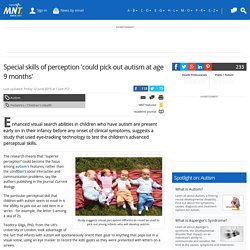
The research means that "superior perception" could become the focus among autism's features, rather than the condition's social interaction and communication problems, say the authors publishing in the journal Current Biology. The particular perceptual skill that children with autism seem to excel in is the ability to pick out an odd item in a series - for example, the letter S among a sea of Zs. Teodora Gliga, PhD, from the UK's University of London, took advantage of the fact that infants with autism will spontaneously orient their gaze to anything that pops out in a visual scene, using an eye tracker to record the kids' gazes as they were presented with letters on a screen.
Dr. Study: Price tag of autism in the U.S. exceeds $236 billion per year - LA Times. Good health is priceless, but autism spectrum disorders can be very expensive.
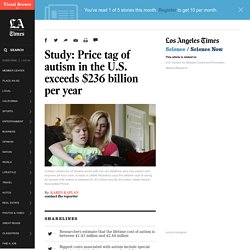
A new study estimates that the lifetime cost of being diagnosed with autism in the United States is somewhere between $1.43 million and $2.44 million. Either of those totals is enough to give most people sticker shock. In autism, the brain's response to speech speaks volumes. When language delays or social detachment mark a baby for a diagnosis of autism, dark clouds cast that child's future in shadow.
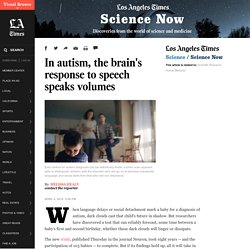
But researchers have discovered a test that can reliably forecast, some time between a baby's first and second birthday, whether those dark clouds will linger or dissipate. The new study, published Thursday in the journal Neuron, took eight years -- and the participation of 103 babies -- to complete. But if its findings hold up, all it will take in the future to clarify an autistic child's prognosis is a nap, a mellifluous nursery rhyme and a magnetic resonance imaging scanner. The new research demonstrates that even in sleep -- and at an age when even some normally developing babies also lack words -- a baby's brain response to spoken language can reveal whether that child is likely to develop speech, comprehension and social skills or whether his social and expressive disabilities are likely to remain profound.
Transition From School to Work. By Temple Grandin During my travels to many autism conferences I have observed many sad cases of people with autism who have successfully completed high school or college but have been unable to make the transition into the world of work.
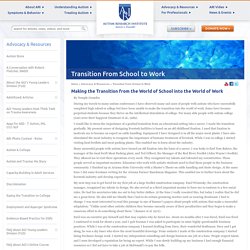
Some have become perpetual students because they thrive on the intellectual stimulation of college. For many able people with autism college years were their happiest (Szatmari et al., 1989). I would like to stress the importance of a gradual transition from an educational setting into a career. I made the transition gradually. Study shows connection between key autism risk genes in the human brain. A new study reveals an important connection between dozens of genes that may contribute to autism, a major step toward understanding how brain development goes awry in some individuals with the disorder.
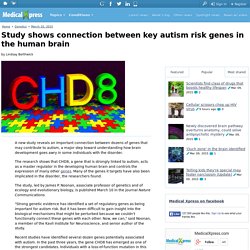
The research shows that CHD8, a gene that is strongly linked to autism, acts as a master regulator in the developing human brain and controls the expression of many other genes. Many of the genes it targets have also been implicated in the disorder, the researchers found. The study, led by James P. Noonan, associate professor of genetics and of ecology and evolutionary biology, is published March 10 in the journal Nature Communications. Autism is largely down to genes, twin study suggests. 4 March 2015Last updated at 11:54 ET By Michelle Roberts Health editor, BBC News online Individuals with autism have less activity in the amygdala (shown in red), which plays a key role in processing emotions Autism is caused by genetic make-up in 74-98% of cases, a Medical Research Council study of 516 twins indicates.
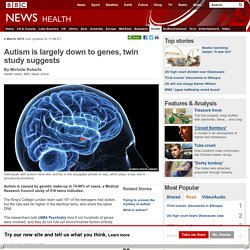
The King's College London team said 181 of the teenagers had autism, but the rate was far higher in the identical twins, who share the same DNA. The researchers told JAMA Psychiatry tens if not hundreds of genes were involved, and they do not rule out environmental factors entirely. Press Releases. Significance As described above, the MIA mouse is considered to be an environmental model of autism, that is, there is nothing special about the MIA mice prior to their in-utero exposure of the infectious mimic.
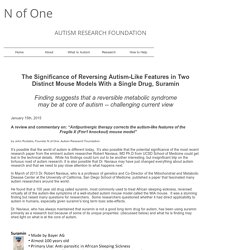
They are that way because of what happened to them. The fragile X mouse is considered to be a genetic model of autism, that is the mice were pre-determined to have fragile X and can never be cured of that underlying mutation. Suramin seems to improve abnormalities seen on both models which suggests it is working at a very deep, fundamental level - perhaps at the very core of what manifests itself as autism. Autism '23% more likely in babies born by C-section' Britain has seen huge rise in C-sections which now account for 1 in 4 birthsDoctors encourage procedure when there is a possibility of complications Expert warns further research is needed to explain the link with autism By Sophie Borland for the Daily Mail Published: 00:10 GMT, 27 October 2014 | Updated: 08:52 GMT, 27 October 2014 Babies born by Caesarean section may be more likely to develop autism, research shows.
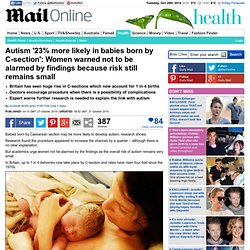
Research found the procedure appeared to increase the chances by a quarter – although there is no clear explanation. Program helps Volusia parents get early autism diagnosis. The district is the only school system in the country to have access to a program that allows school staff members to receive training and work with children before they reach the typical school age.
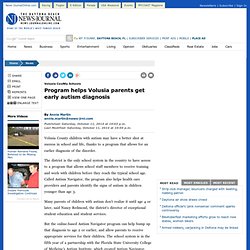
Called Autism Navigator, the program also helps health care providers and parents identify the signs of autism in children younger than age 3. Many parents of children with autism don’t realize it until age 4 or later, said Nancy Redmond, the district’s director of exceptional student education and student services. But the online-based Autism Navigator program can help bump up that diagnosis to age 2 or earlier, and allow parents to receive appropriate services for their children. Need for Services for Parents of Children with Autism. Like with most families, parents of children with autism experience immense joy in sharing in the accomplishments and growth of their children. However, in addition to the traditional pride and delight that comes with being a parent, parents of children with autism must also find triumph in what, for many onlookers, may seem to be insignificant interactions and negligible occurrences.
Reciprocating a greeting, or imitating a short sound, can be cause for massive celebration for families of children with autism. Some of these families have become accustomed to relishing in these proportional successes, acting as a bridge over more difficult times, and reminding them of their child’s potential to flourish in the world. Of course, all parents face daily struggles.
Autism as a disorder of prediction. Very Early Intervention Tied to Autism Improvements. Children diagnosed with autism who received very early low-intensity intervention had far fewer symptoms of the disorder after the intervention ended, a small pilot study found. Seven children diagnosed with autism at ages 6 months to 15 months who underwent a variety of interventions by parents and healthcare providers had lower rates of autism spectrum disorder (ASD) at 36 months than a group of children with similar symptoms who did not undergo the interventions, according to Sally Rogers, PhD, of the University of California Davis, and colleagues.
"Because this was not a randomized study, no conclusions about the efficacy of the experimental intervention can be drawn," the authors wrote online in the Journal of Autism and Developmental Disorders. Differences May Appear Early Several studies have found that differences in development between children with autism and typically developing children begin to appear as early as 6 to 12 months of age, the authors noted. New study finds link between autism and childhood language delay. By Voice of Russia UK A new study led by researchers from the University of Cambridge has found that a common characteristic of autism – language delay in early childhood – leaves a ‘signature’ in the brain.
The results were published on September 23 in the journal Cerebral Cortex. Mom’s iron intake may be important for autism risk: study. By Kathryn Doyle NEW YORK (Reuters Health) - Iron intake during pregnancy might be associated with autism risk in the infant, a new study suggests. Researchers found that moms of kids with autism were less likely to remember taking iron supplements before and during pregnancy than other moms. That alone is not enough to prove a link, however. “Even though we found an association, it’s just an association and needs to be replicated,” said lead author Dr. Rebecca J. “If this is replicated, it will reinforce that women should be following current specific recommendations for iron intake before they get pregnant, during pregnancy and during breastfeeding,” said Schmidt, who worked on the study in the department of public health sciences at the School of Medicine at the University of California, Davis.
Folic acid, or vitamin B, deficiency has also been linked to autism risk. The researchers also asked about fortified cereals and other dietary sources of iron. Agent reduces autism-like behaviors in mice. Boosts sociability, quells repetitiveness — NIH study National Institutes of Health researchers have reversed behaviors in mice resembling two of the three core symptoms of autism spectrum disorders (ASD). An experimental compound, called GRN-529, increased social interactions and lessened repetitive self-grooming behavior in a strain of mice that normally display such autism-like behaviors, the researchers say.
Autism rates now 1 in 68 U.S. children: CDC. Your video will begin momentarily. The new number is a 30% increase from two years agoAutism remains more common in boys than in girlsThe report doesn't say why the incidence of autism is rising (CNN) -- One in 68 U.S. children has an autism spectrum disorder (ASD), a 30% increase from 1 in 88 two years ago, according to a new report released Thursday by the Centers for Disease Control and Prevention. This newest estimate is based on the CDC's evaluation of health and educational records of all 8-year-old children in 11 states: Alabama, Wisconsin, Colorado, Missouri, Georgia, Arkansas, Arizona, Maryland, North Carolina, Utah and New Jersey.
Environmental factors as important as genes in understanding autism. Environmental factors are more important than previously thought in understanding the causes of autism, and equally as important as genes, according to the largest study to date to look at how autism runs in families. Young Adults on the Autism Spectrum Face Tough Prospects for Jobs and Independent Living. PHILADELPHIA, September 4, 2013 Dr. Paul Shattuck is a new faculty member with the A.J. Autism After 16 - Autism News, Articles featuring adult autism and transition. The Affordable Care Act and Autism and Related Conditions. The Affordable Care Act contains important provisions for individuals with autism and related conditions and their families. Under the new health care law: Most health insurance plans are no longer allowed to deny, limit, exclude or charge more for coverage to anyone based on a pre-existing condition, including autism and related conditions.All Marketplace health plans and most other private insurance plans must cover preventive services for children without charging a copayment or coinsurance.
This includes autism screening for children at 18 and 24 months.The Affordable Care Act prohibits health plans from putting a lifetime dollar limit on most benefits you receive. Hiring workers with autism not altruistic, it’s just good business. LONDON, June 4 (Reuters) - Some call it neurological diversity, others see it as autism's fight back. Companies Find Fruitful Results When Hiring Autistic Workers. When Teachers Insurance and Annuity Association and College Retirement Equities Fund purchased a massive apple orchard in Washington state as part of its investment portfolio, managers soon discovered that workers often would show up drunk or not show up at all. "We needed a better workforce, people who really wanted to do the work," says Heather Davis, senior managing director and head of global private markets for the Fortune 100 financial-services organization headquartered in New York.
Needing reliable workers, the company took an unconventional turn: It decided to focus on hiring employees with autism for its Fruits of Employment program. The move has paid off, Davis says. "They take a bit longer to train, but once they're trained, they're excellent," Davis says. Social Involvement of Children with Autism Spectrum Disorders in Elementary School Classrooms.
Association of oxytocin receptor (OXTR) gene variants with multiple phenotype domains of autism spectrum disorder. Brief Report: IQ Split Predicts Social Symptoms and Communication Abilities in High-Functioning Children with Autism Spectrum Disorders. Social-Emotional Issues in Autism Spectrum Disorders. Qualitative impairments in social interaction is one of the defining characteristics for the diagnosis of Autistic Disorder and for Asperger syndrome, according to the DSM-IV-TR (APA, 2000).
'Exhausted' parents leave autistic son at government office - Ottawa. Unable to get enough help from social services, an Ottawa family says they had no choice but to leave their son — who is living with severe developmental delays — in the hands of the government. Autism Information. Autism - or more precisely the autism spectrum disorders (ASDs) - represents a broad group of developmental disorders characterized by impaired social interactions, problems with verbal and nonverbal communication, and repetitive behaviors, or severely limited activities and interests.
Topics: General Information Signs & Symptoms Screening & Diagnosis Treatments Causes, Risk Factors, & Prevalence Research & Clinical Trials Publications Organizations General Information The Affordable Care Act and Autism and Related Conditions Autism Spectrum Disorders (ASD) Facts from the CDC – The Centers for Disease Control and Prevention (CDC) offers facts about autism, types of ASDs, signs and symptoms.
Living With Autism: Going to Middle School. Starting middle school is stressful for any student, but the process can be even more challenging for a student on the autism spectrum (ASD) and for his or her parents. Many things will be different. Social isolation of young adults with autism spectrum disorder examined. AUSM - Autism Society of Minnesota - AUSM - Autism Society of Minnesota. Organization for Autism Research. How Will the New Definition of Autism in DSM-5 Affect Children? Parents, Advocates Anxious Over Changes.